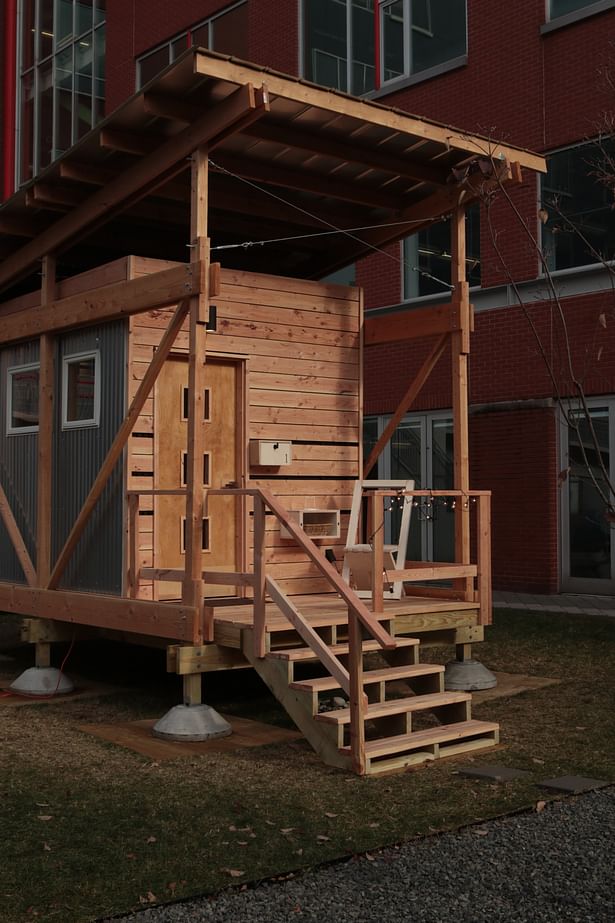
Newark, NJ

*NJIT HCAD students were recently awarded two honors: the Design for Social Impact Award & Built Environment Award at the Core 77 Design Awards for their project "Place of Dwelling" (POD). Read more about their design-build project below.
The following press release is from a December 13, 2021 school news announcement.
The development of the POD is a testament to the foresight of Tom Wisniewski, managing partner of Newark Venture Partners. The funding support he provided for this prototype shelter enabled it to go from a design on paper to a fully realized dwelling unit. Inspired by the efforts of the city in the construction of Hope Village, Wisniewski wanted to do even better and was confident in the capabilities that Pellegrino and Firestone would bring to the project. The challenge of the studio, as outlined in the course syllabus, was to design a unit that could be built quickly, inexpensively and meet the needs of people seeking housing. ““They exceeded all expectations. This is an amazing dwelling…for anyone. It serves the needs of affordable housing, but it’s great design appeals to the broad population as well. I see huge social impact and the investment potential necessary to make this a sustainable business,” said Wisniewski.
Pellegrino credits the success of the project to several factors, ”This could only happen in a city like Newark, where you have the flexibility, initiative and excitement to do something like this, and the fact we can do this at NJIT. It is also the timeliness of the solution, in the face of a national housing crisis and a global pandemic, where many people do not have the option to ‘shelter in place’. These students are so passionate about the project they really delivered the work of four studios in the time of one because they see the power and potential of it.”
Guest reviewers who came to the studio presentation and toured the unit were in agreement on its potential. Christopher Watson, planning director for the City of Newark, saw the potential for training individuals in construction skills in the process of building these units. Christine Liaukus, program manager for Housing and Community Development at the NJIT Center for Building Knowledge, who is an expert in sustainable architecture said, “The proportions of the POD are ideal for being built to the Passive House standard, which comprises a set of design principles for extremely energy efficient, comfortable buildings. The POD’s surface to volume ratio is low, meaning that the amount of exterior envelope to interior volume is optimized, so heat loss/gain is minimized.”
Students were very enthusiastic about both the purpose of the project and what they were learning. To really understand the needs they were designing a solution for, students got input from residents and the architect of Hope Village as well as Sakinah Hoyte, the city’s Homelessness Czar. She provided students with the demographic profiles of the Newark community members they are designing for. “We have three extremely vulnerable groups who need housing: people with disabilities and other health issues, people who have partnered for safety on the street and that need to be housed together, and those who need shelter from domestic violence who often have children with them.”
During their final presentation, students shared their mandate to produce a low-cost and deployable housing unit, their research on the unhoused population in New Jersey, and their design process, and construction methods. They also addressed how they designed the POD to accommodate each demographic group, the customized furniture, and flexibility of the furnishing systems to be rearranged depending on the occupant's needs. They also produced a set of construction documents, documented the costs (just over 10K including furniture), and tallied up what they were able to address in the time and budget allotted, noting what more might be improved on for the next prototype.
Through our whole investigation, the cause, the ‘why’ of it was very personal for me,” said Leidy Lopez. “I am from Colombia. I had relatives who lived in the streets, so I saw firsthand what it is to be homeless and their needs. Visiting Hope Village also opened our perspectives to that. The fact that we went through that transition to caring about ‘why’ we are building it, rather than the build itself, that was important.”
“Through this studio, we challenged the students' assumptions about what it means to be an architect. We believe that as a profession, we have a responsibility to confront issues such as the housing crisis, the climate crisis, and the vast inequity of our society. We also believe that the design-build experience is invaluable for any aspiring architect - whether they decide to continue physically building or not. You begin to think very differently about what materials you choose and how the building goes together once you are confronted with the challenge of physically executing your design,” said Firestone.
View a gallery of the studio here.
No Comments
Block this user
Are you sure you want to block this user and hide all related comments throughout the site?
Archinect
This is your first comment on Archinect. Your comment will be visible once approved.